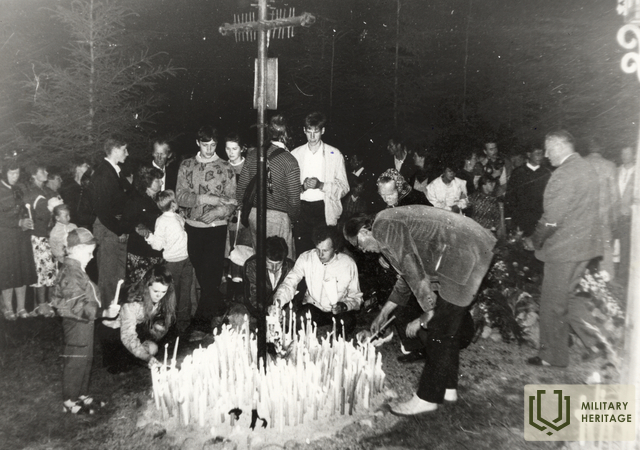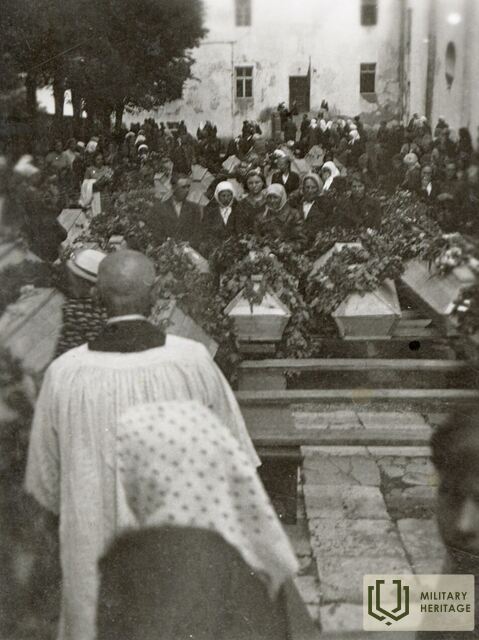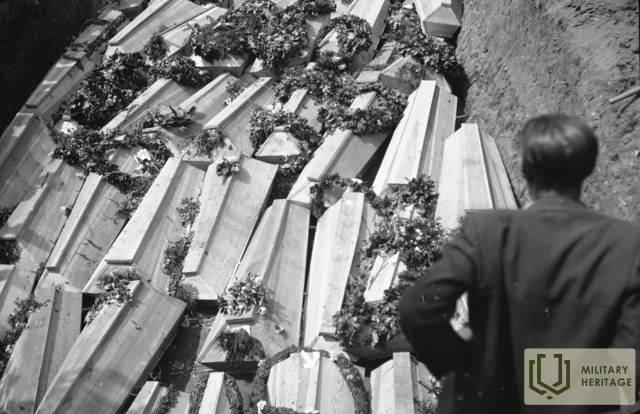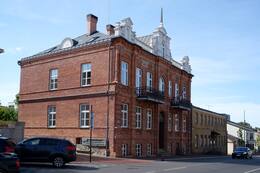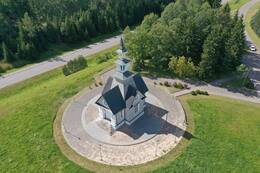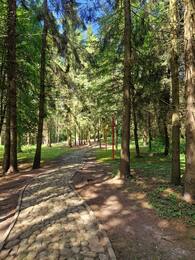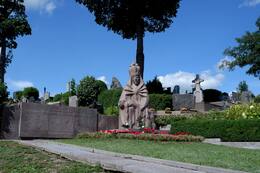Rainiai massacre II WW2
The Rainiai massacre is the massacre of political prisoners in Telšiai prison by the USSR military and repressive institutions on June 24-25, 1941. It began at the beginning of the USSR-Germany war, when martial law was declared in the frontline areas and all political prisoner cases were transferred to military tribunals. The majority of the prisoners were sentenced to be shot, while others were evacuated to the depths of the USSR.
Telšiai Prison held 162 prisoners at the time, 76 of whom were political prisoners interrogated by the NKGB. As early as June 23, the prison's political leader A. Vaitkus planned to transport all the prisoners, but the plan failed when the local leaders of the Communist Party, NKVD, and NKGB fled the city without providing them with transportation.
On the morning of June 24, the prison was surrounded by Red Army soldiers led by Dontsov, who called himself a Red Army major (it is believed that he was the commander of a unit of the 123rd division of the 8th army of the USSR). Further preparatory work was led by the deputy chief of the Kretinga district of the NKGB, Lt. Yermolaev.
The NKGB Telšiai County Chief Petras Raslanas, his deputy Lt. Zhdanov, the head of the political department of the USSR 8th Army Kompanec, and the chairman of the Telšiai Executive Committee Domas Rocius, who arrived at the prison, reviewed the cases and formally confirmed the death sentences. Mr. Raslanas later stated: "I am convinced that there was not a single innocent person there."
The prisoners were taken from their cells to the guardhouse, where their hands were tied and their mouths gagged. They were stacked one on top of the other in trucks. At dawn on June 25, the trucks with the prisoners turned towards Luokė, to the Rainiai forest.
During the execution, measures were taken to prevent the screams of the victims from being heard - car engines were turned on, guards were posted. The prisoners were brutally tortured: they were burned at the stake, shocked with electric current, scalded with boiling water and cabbage, beaten with rods, and starved with bayonets. Many had their genitals, noses, and tongues cut off, their eyes gouged out, their skin peeled, and their skulls cracked. Only 10 prisoners were simply shot.
Among those killed were the three Antanavičiai brothers (Antanas, Jonas and Juozas), the brothers Povilas and Stasys Balsevičiai, the brothers Boleslovas and Petras Kavoliai, and the brothers Andrius and Jonas Rudokai. A total of 73 people were killed on the spot, and three more – Pranciškus (Pranas) Razgus, Petras Sūdžius and Aleksandras Vyšniauskas – were shot while trying to escape in the vicinity of the village of Džiuginėnai, Telšiai County.
On the morning of June 26, an employee of the restored Telšiai municipality discovered torture tools at the scene of the massacre: a tractor, electric generators, 3 car engines, a bonfire, and barrels of boiled cabbage. On June 28, four pits with victims were discovered. The remains of 65 of the tortured were buried in the old Telšiai city cemetery, and the remains of 10 people were buried by their relatives in other places.
A medical report by Dr. Leonardo Plechavičius, published in a Nazi propaganda publication in 1943, detailed the signs of torture of all the victims. In an attempt to erase the memory of this event, the Soviet authorities demolished the chapel that had begun to be built in the Telšiai city cemetery and cut down the Rainiai forest.
The main organizers of the massacres escaped punishment: Petras Raslanas hid in Russia after 1990, where he died, and Nachmanas Dušanskis, who participated in the interrogation of at least 13 victims, has been living in Israel since 1989, which refused to extradite him to Lithuania.
In 1991, to commemorate the 50th anniversary of the massacre, a new Chapel of Suffering was consecrated in Rainiai, the ceiling of which is decorated with frescoes by the artist A. Kmieliauskas with the painted martyrs of Rainiai. At the site of the massacre, about 300 m from the chapel, a pink granite monument "Three Crosses" (sculptor Regimantas Midvikis) was erected and a Memory Oak Grove was planted. In 1995, this entire memorial site was declared a historical and memorial monument of national significance.
More information sources
Related timeline
Related objects
Former Telšiai Prison
The former Telšiai Prison building stands on Respublikos Street, in the central part of Telšiai city.
After the Telšiai fire of 1908, a private individual, a wealthy Jew named Neiman, built a neo-Gothic building in the historicist style. He agreed with the occupying tsarist authorities that he would build the building for the purpose of the district police board building that had burned down in the fire, according to the conditions specified by the authorities, and rent it to the authorities. It was one of the most beautiful buildings in Telšiai. During the First World War, the building was adapted for the Telšiai district prison. It was used as a prison both during the period of independent Lithuania (1918-1940) and during the Soviet occupation, until the beginning of the 1950s. In 1940-1941, 1944-1953, the building housed the NKGB–MGB–KGB Telšiai district internal prison.
On June 22, 1941, with the outbreak of the imperialist war between the Soviet Union and Nazi Germany, 162 prisoners were imprisoned in Telšiai prison – 76 NKGB interrogated prisoners. On June 23, there was an attempt to transport all the prisoners, but this plan failed because the local leaders of the Communist Party, the NKVD and the NKGB fled the city. No vehicles were provided for the transport of the prisoners. On the morning of June 24, 1941, Telšiai prison was surrounded by a unit of the 123rd Division of the 8th Red Army, and a three-judge court was hastily formed, headed by the NKGB Telšiai County Chief Petar Raslanas – so he, the Chairman of the Telšiai Executive Committee Domas Rocius and the Deputy Chief of the NKGB Kretinga County, State Security Lieutenant Yermolajevas, and others. All 76 political prisoners in Telšiai prison were sentenced to death. The other prisoners were released home. The short night of June 25th - dawn was already timidly breaking in the east when trucks with prisoners moved towards Rainiai. Three prisoners managed to escape from the trucks - unfortunately, they were soon caught by Red Army bullets... The mutilated bodies of 73 prisoners were accidentally found in Rainiai on June 28, 1941.
Later, the Telšiai Music School was located in the building, which operated here until 1994. Unfortunately, the building was severely damaged both externally and internally during the Soviet era.
During the restoration of the building, inside the walls, inscriptions of names, Gediminas' pillars, and various dates were discovered. Walled-up grottoes were also discovered.
On June 24, 1997, a memorial plaque was unveiled near the building by the Telšiai branch of the Lithuanian Prison Service, dedicated to the memory of 73 political prisoners of Telšiai Prison who were tortured in the Rainiai forest on the night of June 24-25, 1941.
In 2006, in memory of the 65th anniversary of the martyrdom of the Rainiai Martyrs, an artistic memorial plaque was unveiled near the former prison (author - Gintaras Gailius, architect - Algirdas Žebrauskas).
Rainiai Chapel of Suffering
The Rainiai Chapel of Suffering is located in the village of Rainiai, at a distance of five kilometres from Telšiai, off road No. 160 Telšiai-Varniai-Laukuva.
On 25 and 26 June 1941, one of the most horrific massacres in the history of the Soviet occupation of Lithuania took place in Rainiai Forest. At night, the Red Army and the Soviet repressive authorities brutally tortured 75 political prisoners to death in Telšiai Prison. A few days later, a passer-by found the victims buried in a mass grave.
In 1943, a chapel was built in memory of the victims, which was built according to the sketch of the architect Jonas Virakas. In 1944, with the return of Soviet rule, the chapel was destroyed. Later, in 1990, after Lithuania regained its independence, the architect A. Žebrauskas started to build a new chapel based on the sketches by the same author. The chapel was consecrated on 23 June 1991 to commemorate the 50th anniversary of the Rainiai massacre.
The Rainiai Chapel of Suffering is dedicated not only to the martyrs of the Rainiai but also to the memory of all the victims of Soviet terror. A stone cross carved by sculptor R. Midvikas is erected in the forest near the chapel, where political prisoners were tortured. Three more wooden crosses painted in the colours of the national flag can be seen on the road.
Memorials in Rainiai Forest - the place of the martyrs' murder
The Rainiai Passion Chapel is located in the village of Rainiai, 5 km from Telšiai, next to road 160 Telšiai-Varniai - Laukuva.
On June 25-26, 1941, one of the most horrific massacres in the history of the Soviet occupation of Lithuania took place in the Rainiai forest. At night, 75 political prisoners from Telšiai prison were brutally tortured by the Red Army and the repressive institutions of the USSR. The victims, buried in a common grave, were found a few days later by a random passerby.
To honor the victims of the massacre, the construction of the Chapel began in 1943, based on the idea of architect Jonas Virakas. The Soviet authorities, upon returning, demolished it in 1944. Later, in 1990, after Lithuania regained its independence, architect A. Žebrauskas, based on the drawings of the same author, began building another chapel. The chapel was consecrated on June 23, 1991, commemorating the 50th anniversary of the Rainiai Massacre.
The Rainiai Suffering Chapel is not only dedicated to the memory of the Rainiai martyrs, but also perpetuates the memory of all victims of Soviet terror. In the forest next to the chapel, where political prisoners were tortured, a stone cross carved by sculptor R. Midvikis was erected. Three more wooden crosses, painted in the colors of the national flag, stand along the way. They were erected by local people shortly after the massacres, but the villagers drowned them in the Viešvėnai Pond. Only recently, after the pond was drained, were the crosses found, painted and restored.
Tombstone "Pieta"
The monument stands in the old cemetery of the city of Telšiai.
On the night of June 24-25, 1941, in the Rainiai forest, employees of the Telšiai County Department of the NKVD-NKGB and their assistants executed 75 political prisoners from the Telšiai prison. The victims were tortured in the most brutal ways – some had their eyes gouged out, their ears and genitals cut off, and their heads crushed. Only 10 prisoners were shot. After the massacre, not a single living witness remained, except for the executioners themselves. Near the burial site of the victims, 3 corpses of Red Army soldiers with gunshot wounds to the back of the head were found buried, their burial place is unknown. The remains of 65 victims of terror were buried in the old cemetery of the city of Telšiai. During the Soviet occupation, attempts to commemorate the anniversary of the Rainiai massacre, to take care of the grave or to install a tombstone with names were prevented.
Today, the cemetery is home to the monument "Pieta", unveiled on June 23, 1996, depicting the Mother of God holding the body of Christ taken down from the Cross on her knees. The authors of the monument are the artist-sculptor Antanas Kmieliauskas, sculptor Osvaldas Neniškis and architect Algirdas Žebrauskas.
Related stories
Rainiai Massacre: An NKVD Crime Without Witnesses
On June 24-25, 1941, in the Rainiai forest, near Telšiai, the NKVD and Red Army soldiers brutally tortured 73 political prisoners from Telšiai prison - this became one of the most horrific Soviet crimes in Lithuania.
Rainių žudynės: netikėtai atrastos aukos
On June 24-25, 1941, in the Rainiai forest, near Telšiai, the NKVD and Red Army soldiers brutally tortured 73 political prisoners from Telšiai prison - this became one of the most horrific Soviet crimes in Lithuania.




